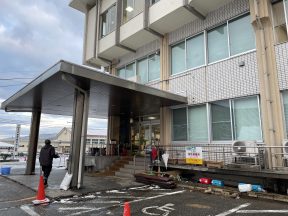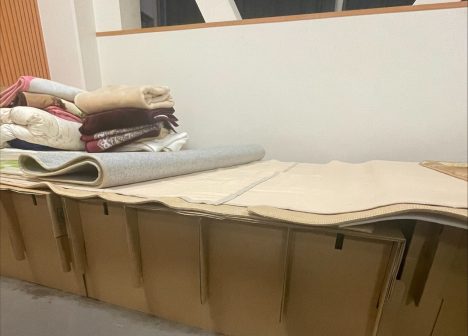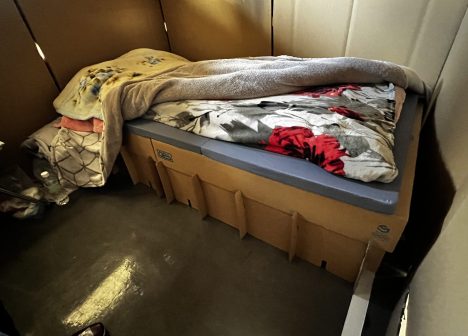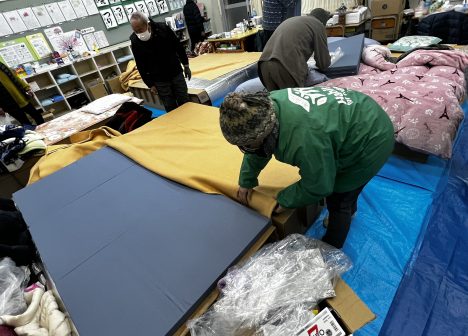(Original Japanese article posted February 5th, 2024)
Despite one month passing since the Noto Peninsula earthquake, we've heard from many evacuees that "It's as if time is still frozen at New Year's Day". Habitat Japan began our disaster relief efforts by first conducting an initial survey of the disaster area from January 12th. As a result, we set the Monzen-machi district of Wajima City as our base of operations from which we continue to work to meet the needs of those affected in Monzen-machi and the surrounding areas.
 After the decision was made to offer our support for Monzen-machi in earnest, one cause we have worked hard on is the improvement of the living environments found within evacuation shelters. Monzen-machi is home to many old homes, many of which were damaged or destroyed by the quake. In addition, utilities such as water lines remain unusable, necessitating the continue evacuation of most all evacuees in the area for some time.
After the decision was made to offer our support for Monzen-machi in earnest, one cause we have worked hard on is the improvement of the living environments found within evacuation shelters. Monzen-machi is home to many old homes, many of which were damaged or destroyed by the quake. In addition, utilities such as water lines remain unusable, necessitating the continue evacuation of most all evacuees in the area for some time.
When we first observed life within evacuation shelters, we were sad to find that a portion of evacuees were forced to sleep on hard tiled floors with only sheets of cardboard and a blanket under them at night. With the introduction of cardboard beds for a portion of denizens, the problem of sleeping on the cold floor was alleviated, yet many still complained that they were hard and uncomfortable without a proper sleeping mat.
To those who still can't return to their damaged houses, evacuation shelters are invaluable stand-ins for homes from which evacuees must base their lives out of for the time being. With Habitat Japan being a housing support organization, we took it upon ourselves to help ensure that evacuees had a safe and decent living environment to rest their minds and bodies in the face of disaster. To achieve this, we began considering methods to provide shelters with foam sleeping mats. Luckily, through our relationship with NGO Collaboration Center, who we collaborated with after the Kumamoto earthquake in 2016, we were introduced to Imae Industries who agreed to provide urethane sleeping mats free of charge.
Working to distribute mats as soon as possible, Habitat Japan visited almost 20 different evacuation centers in Monzen-machi and surveyed the need for sleeping mats at each. Evacuation centers, often designated community centers or schools, vary greatly in their size and facilities. For communities without such designated centers nearby, we saw them relying on the facilities of local businesses or even plastic greenhouse tents. Through visiting evacuation centers, we were able to witness community ties in action and were able to envision how these ties can go on to support livelihoods, health, and reconstruction. Beyond that we saw that while some centers had their material needs such as sleeping mats handled, many others were still lacking basic necessities and supplies.


 Through this initial survey we found there was need for 150 sleeping mats in total. Anticipating further requests after the fact, we ended up requesting 200 mats total from Imae Industries.
Through this initial survey we found there was need for 150 sleeping mats in total. Anticipating further requests after the fact, we ended up requesting 200 mats total from Imae Industries.
On the day of distribution, Imae Industries drove the truck carrying the mats around to each shelter in Monzen-machi and helped us distribute all of them smoothly. As we began our distribution, as expected additional requests came in from a number of shelters, and by the end of the day we had distributed all 200 foam sleeping mats.
We were even able to hear kind thanks of evacuees such as “It’s great to have a sleeping mat! Sleeping on cardboard was so hard, I would wake up a lot at night. With the mat I can sleep soundly. Thank you.”
Going forward, Habitat Japan will continue lending an ear to evacuees to determine their needs, tackling difficulties to ensure that evacuees have a safe and decent place to rest in the wake of disaster.
To support us as we continue our post-disaster efforts, please check here.



